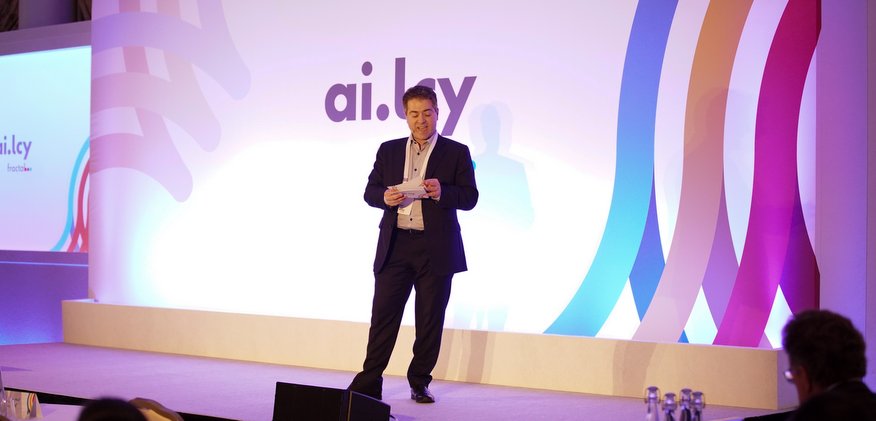Event Summary
Senior business leaders convened at The Langham in London on February 26 for ai.lcy, the fifth in Fractal’s series of artificial intelligence (AI) events. This time, leading thinkers from academia and business posed key questions about the future relationship between humans and machines on the core theme of AI meets design.
The event arrived at a crucial point for AI within businesses.
As Fractal co-founder Srikanth Velamakanni noted, the question is no longer whether we have the required data or technology to implement AI systems. Rather, we must decide how we will use this phenomenal power.
BBC’s Leo Kelion opened a day of highly stimulating discussions by introducing the central themes: Asking the right questions to solve the right problems; designing with AI for customer delight, and combining emotional intelligence with AI.
Reframing the question
Leo cited the classic Albert Einstein quote, “If I had an hour to solve a problem I’d spend 55 minutes thinking about the problem and five minutes thinking about solutions.”
He added that there are times today when AI feels more artificial than intelligent. It works very well in a constrained and controlled environment, but if, for example, we do not phrase our query correctly to an Alexa-enabled device, it struggles to respond.
This served as a fitting curtain-raiser, as the day’s speakers continued to assess how we reframe business questions, to deliver answers through AI and design.
Johan Aurik, Partner and Chairman Emeritus at Kearney observed that while nine out of ten business leaders say AI is of strategic importance, just four out of ten have implemented an AI solution, and much fewer still have reported success.
Fireside chat – AI: Making it work in the real world.
Hannah Fry, Johan Aurik and Srikanth Velamakanni
He built on this by remarking that too many businesses see AI as a tool for delivering efficiency, rather than growth. However, if we begin with genuine customer problems and view technology as an enabler of innovative solutions, we will build the growth mindset that unlocks AI’s potential.
“Don’t start with the technology and what it can do”, Johan advised, as this will inevitably shape how we design our systems.
But how do we even know which questions to ask, to ensure that we are solving the right problems?
There were numerous takes on this pressing query throughout the day.
Natwar Mall, CEO of business analytics platform Cuddle.ai, emphasized that the key indicators are often hidden in plain sight.
We tend to overestimate our ability to digest lots of complex information, Natwar continued. This is shown in the complex performance dashboards, so many businesses employ.
With so much data at their disposal, employees are often overwhelmed rather than empowered. Natwar shared the statistic that just 29% of businesses link analytics to action today, so the current approach is clearly lacking in effectiveness.
Instead, AI (most notably, through Natural Language Processing) can let employees speak to the technology and receive useful responses about the company’s data. The data that these exchanges produce can be invaluable when trying to understand the typical pain points people encounter, too.
Future of decision-making @ work.
Natwar Mall
Forrester’s James McCormick later predicted that insights-driven businesses, such as Uber or Tesla, will generate $1.8 trillion in 2021, so the prize on offer is sizable for those that can break through this impasse.
Cuddle.ai uses “nudges” to help people work more effectively, and Stephen Donajgrodzki from Kellogg Company built on this behavioral science concept in his talk on how data can help us understand what makes people tick.
Stephen warned against some common errors when it comes to framing questions.
Companies often employ surveys to gather insights on how the audience perceives their brand. However, companies shape the audience’s answers through the design of the survey questions.
Stephen posited the following scenario: Ask someone, “How much do you love Coca-Cola?” and the question leads them to state that they love the brand. Ask them, “How much do you love Coca-Cola, compared to how much you love your mother?” and the frame of reference is markedly different from the outset.
Stephen concluded on a subtle and perceptive note that many brands could learn from: “Awareness in itself isn’t that useful. Understanding why people act is very useful.”
Human behaviors never exist in a vacuum, so we need to pose deeper questions that focus on what people do and why they do it. To “nudge” those behaviors, businesses must know how they want the audience to act.
As Pier Culazzo, Executive Director Data Science Lab & Operations at Visa said, this must also relate to the incentives the business is willing to offer to the customer.
If a company wants to know about their audience’s behavior, they need the audience’s cooperation to access the data. There must be an obvious benefit for the consumer, or they will opt not to share their private information.
Pier pointed out that Visa processes around 130 billion transactions each year, so there is no shortage of data. The challenge is deciding what to do with the data, in the interests both of the company and its customers.
Visa agreed that this could help solve customer problems relating to credit card fraud by using AI to spot anomalous transactions. It has done so since 1993 and estimates that it saves $25 billion per year by preventing these fraudulent transactions.
This is just one example and it represents an impressive win-win for both the company and the consumer, but Pier still sounded a note of caution about using AI without due consideration for how the machine arrives at its answers to our questions.
He suggested, “You constantly need to think about, how do I balance the power of an upgrade versus my need to explain to the consumer how the upgrade came about.” The explicability of some AI systems is still a work in progress, and in many areas we need transparency. If a mortgage or loan application is rejected, the customer should be entitled to an explanation, after all.
How AI and Design together can develop workable solutions and solve problems at scale.
Pier Culazzo, Pranay Agrawal and George Mathew
Designing for Delight: EI + AI
To usher in a new age of partnership between human and machine, we need to know where each party excels – and where they typically fall short.
Dr Hannah Fry tackled this scenario in her fascinating keynote speech, “How to Be Human in the Age of the Machine.”
Hannah, who stars in BBC documentaries about mathematics as well as hosting the superb DeepMind podcast, focuses her academic work on how AI can help solve difficult social problems.
As Hannah noted, the sheer potential of AI brings with it a host of new challenges.
Scientists in the past did not need to worry about the ethics of fluid particles, but AI needs to exist in the dynamic field of the human world. Hannah added, “You can’t just build an algorithm that involves people and decide whether you think it’s good or bad in isolation.”
Hannah offered numerous examples of how bad design has hindered the progress of mathematically sound systems.
She stated that driverless cars are, in strict terms, excellent at driving. They have improved so much that now, a driverless car can execute the component aspects of driving very well, in the testing environment.
However, the machines are not always designed with people in mind. Some models only require human intervention in an emergency, which demonstrates a lack of understanding when it comes to how people function. We do not perform well under pressure; and yet, the cars demand precisely this.
It does not need to be this way.
A good human-centered design would have the machine monitor for potential emergencies and step in to reduce the likelihood of an accident. Tesla and Volvo are just two car companies that have made this shift, taking into account how humans and machines can complement each other’s strengths – and counteract each other’s weaknesses.
Hannah shared a categorization of tasks that can help companies use design and AI to build a partnership between human and machine.
She stated that AI works fantastically well when it comes to specialized situations. It is much more likely to identify minor inconsistencies in patterns, for example, making it highly valuable for disease detection.
On the other hand, people are the experts when it comes to specificity. Hannah saw this as our “human superpower” in the age of AI. We can look at a small number of samples and make a judgment call much more effectively than a machine can.
Hannah summarized her core argument with, “Let the machine filter down all of the boring work, pick out areas of interest, and then let the human with their specificity superpowers come in and check, and decide.”
James McCormick from Forrester agreed with this in his talk, “Digital Data Tech and the Practice of Competing with Experiences.”
He suggested the example of a clothing retailer, Stitch Fix. Many shoppers are faced with decision paralysis when they shop online, as there are simply too many choices on offer.
Stitch Fix uses AI to filter through its inventory and identify the products that best fit each individual customer, based on their taste profile. It then provides a human stylist with some options to choose from, making the decision process simpler and allowing the stylist to focus on what they do best.
The end customer gets a personalized service, and the business can scale their capabilities without needing to hire hundreds of more stylists.
James observed that just 7% of businesses today would qualify alongside Stitch Fix as “insights-driven”. He added that these businesses differentiate themselves by “voraciously competing on experiences”, using a combination of data, insights, and algorithms to create faster, better outcomes for customers.
Dan Makoski, Chief Design Officer at Lloyds Banking Group, provided a unique insight into how his team puts customers in control of their financial lives, using AI and design.
Dan underlined the human element in creating technology products, opening his talk with the suggestion that AI requires EI or Emotional Intelligence.
Humanizing FinTech, by Design.
Dan Makoski
In the banking world as in so many others, it is tempting to think in terms of the products the company can offer.
However, the customer does not think of current accounts or savings accounts at a deeper level. Beyond those surface needs, the customer thinks in terms of milestones and moments. They may think of saving towards putting their kids through college or going on a family vacation, for example.
So far, banks have struggled to incorporate that truth into their customer-facing product.
Dan and his team tackled a complex question, to try and arrive at an altogether new answer: “What would banking feel like if it were more human?”
They visited their bank branches, held focus groups, and had plentiful brainstorms in their office, with the objective of pinning this down to one universal metaphor.
In the end, this was the metaphor of a journey.
Dan explained that people know what they are striving for, yet they feel imprisoned by their finances. They can see the goal, but then they ask, “How do I get there? What are my options? What happens if circumstances change?”
This is where AI should enter the equation. Dan discussed the example of Waze, which uses Global Positioning System (GPS) data and auto-rerouting algorithms to help people get from A to B, or to C, should they change their mind along the way.
Personal finances could avail of the same AI principles, to help people join the dots between their life milestones.
This was a recurring theme throughout the ai.lcy event: For all of AI’s hugely impressive advances, it works best when it is in the background, empowering people to make better decisions.
The challenge today is not to acquire the power of AI, but rather to harness it. If we apply enough care in framing our questions and designing solutions with people at their heart, AI will help us join the dots to deliver transformational results.
Speakers
Event images

























